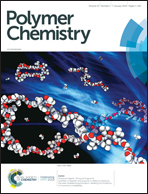Unlocking the action mechanisms of molecular nonlinear optical absorption for optical conjugated polymers under aggregation states†
Abstract
The intense interactions of optical conjugated polymers (OCPs) under molecular aggregation states attenuate their molecular nonlinear optical absorption (MNOA) performances. An effective route to unlock the action mechanisms of MNOA for OCPs under aggregation states by auxiliary theoretical calculations is developed in this work. Three typical molecular structures of OCPs (donor 1–donor 2 (D1–D2)-type, donor 1–acceptor (D1–A)-type and donor 1–donor 2–donor 1–acceptor (D1–D2–D1–A)-type) applied to nonlinear optical absorption materials are constructed by thienyl, carbazolyl and fluorenyl moieties. The relationships between the molecular structure and nonlinear optical absorption performance for the three types of OCPs are then predicted by theoretical calculations, and the D1-A-type and D1–D2–D1–A-type OCPs are verified to possess better MNOA performances. Furthermore, based on the experimental data, the optimum proportions of the donor unit and the acceptor unit are determined to obtain the best MNOA performance for D1–D2–D1–A-type OCPs. The MNOA for different doping mass ratios of the D1–D2–D1–A-type OCP in OCP/PMMA and OCP/PS composite films is also discussed, and the action mechanism of the aggregation state in solid composite films is revealed. These results suggest that this new strategy to prepare MNOA materials could promote further applications of OCPs in the field of nonlinear optical (NLO) devices.



 Please wait while we load your content...
Please wait while we load your content...